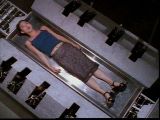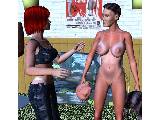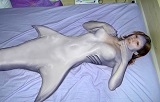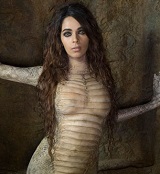Transformation Stories FAQ
Transformation fetish is a context of sexual fetishism in which a person becomes sexually aroused by descriptions or depictions of transformations, usually the transformations of people into other beings or objects.
The Transformation, or "TF" community does not seem to have a specific name for its members; often the generic "TF fan" is used, however this term is also applied to people who have a non-sexual interest in Transformation fiction. The internet community consists mainly of webpages featuring artwork or stories dealing with transformations, although there is no distinct barrier between fetish and non-fetish material.
Note that sexually based transformation fetish materials are not necessarily centred around BDSM or pain-infliction fetishes, as is sometimes claimed; the "thrill" of the material comes from the transformation aspect itself, and other fetishes triggered as a consequence of the transformation could be considered to be side-effects. The overtly sexual aspect of the fetish shares characteristics with various roleplay-centric fetishes in that there may or may not be any actual sexual activity involved.
Most TF media share a few characteristics. They involve a human (of either gender) being transformed into another form. The means of transformation are varied and include viruses or strange chemicals, pills, potions, magic spells or curses, and sex with a creature/person of the form being transformed to. The transformation is usually non-consensual, with the transformer often becoming confused, scared, or angry as the changes take place, although some transformations are gladly accepted and even chosen by the individual.
Representations and genre
Age
Age regression and Age progression, often shortened to AR and AP respectively, are a subgenre of Transformation Fetish wherein the participant's bodily age is increased or decreased. Though there are some stories where the participant's mental age changes with their body, by and large most AR / AP media feature the participant retaining their original mental level of maturity, whatever it may be. This is often a point of plot development within many stories, with the victims usually having difficulty adjusting to how self-sufficient or helpless they may be in their new state as compared to their old state.
A typical Age Regression story features an adult, usually one in an esteemed position or one with many resposibilities (such as a high position in a corporation or a parent of young children) encountering a situation that causes him or her to become younger. Typical causes include all manner of magic and pseudo-science, though a variety of fictitious medical conditions have also been concocted by writers. The most prevalent of these is the aptly titled Age Regression Virus, which is usually shortened to AR Virus or simply ARV.
In these stories the victim will gradually regress, eventually reaching the physical body of an infant or a small child, and then will "bounce," or stop regressing. In other cases, though, the virus goes beyond this, regressing the victim into a pre-natal state or complete disappearance. Many writers have written stories about the AR Virus, and thus the details outside of the basic definition will often differ. One commonly agreed-upon symptom of contracting the AR Virus is frequent excretion of bodily fluid of some manner, presumedly as a method of jettisoning the millions of cells the body casts off as it shrinks.
The typical Age Progression story usually has children as victims, who will increase drastically in physical age but not mental maturity. Unlike Age Regression this usually occurs all at once, rather than in a gradual curve. A staple of these stories, resultingly, are the tearing of clothes the victim wears as they grow, which usually occurs too quickly for the victim to remove them.
Spirit
A type of transformation fetish where the person is aroused by the idea, description, or depiction of a person being spiritually possessed by a spirit, demon, etc. The possessed person's (usually an adolescent) voice changes into something different (usually more mature). In other cases the person after being possessed has a different height, etc.
Gender
A type of transformation fetish where the person is aroused by the idea, description, or depiction of a person of one gender transforming into a member of the other gender; usually the stories depict magical changes. Many of these stories involve magical talismans, rings, or necklaces, and they often involve the 'victim' being involved in sexual situations as a member of the opposite sex.
A typical plot involves a person becoming the opposite sex, engaging in various forms of sexual activity, and eventually becoming so satisfied with their new forms that they decline to change back, even if a cure is readily available. There are, however, sites that attempt to do TG literature without the sexual content. Characters still rarely, if ever, get reverted to their original gender. Most commonly, the transformation is from male to female although female to male stories do exist.
Mind-body
Mind-swap / Body-swap is a category of transformation fetish which can overlap with some of the other categories (notably transgender) is that of an exchange of bodies or minds (not always voluntary, or sometimes voluntary by one party to the exchange but not the other) so that two individuals (human or otherwise) each find themselves occupying the other's body, and usually forced to assume the other's life and identity. This transfer can be caused by several methods: the most plausible is surgical removal of each subject's brain, followed by surgical transplantation of each brain into the other subject's cranium. (This would involve the separation and re-connection of thousands of nerve endings, and the successful healing of the neurons!) More contrived methods include the use of some sort of mind-transfer machine, or magic.
In P.G. Wodehouse's 1936 novel Laughing Gas, a man and a boy are simultaneously anaesthetised in two adjacent rooms with the same experimental anaesthetic. When they regain consciousness, each is occupying the other's body. The transfer is reversed when the two of them suffer a violent collision.
The body-swap is a transgender transformation if one party to the transfer is male and the other female. An example of this is the Star Trek episode "Turnabout Intruder", in which a woman scientist used an alien machine to switch bodies with James T. Kirk: the transfer is conveniently temporary. In Barry Pain's novel An Exchange of Souls, the narrator is confronted by his male friend's fianc�e, who claims actually to be the male friend trapped in the fianc�e's body: apparently the two of them used a mind-transfer machine successfully, but the transfer destroyed the machine and also killed the man's body (containing the woman's mind and identity), thus trapping the man's mind and identity inside his fianc�e's body. The narrator never learns whether the transfer actually took place, or whether the fianc�e is suffering a delusion caused by the shock of her lover's death.
The 1936 horror film The Man Who Changed His Mind features Boris Karloff as the inventor of a mind-transfer machine which works in an unusual fashion: rather than transferring each subject's mind and memory into the other subject's brain, it physically disassembles both brains and reconstructs each brain inside the other subject's skull.
Body
The transformation of a body's shape or size, for example, by shrinking, growing, or gaining muscle mass. Shrinking and growing have their own fandoms in the microphilia and macrophilia fandoms, with more emphasis on the results of the transformations than on the transformations themselves.
There's also the type of modification that involves addition/removal/repositioning of body parts. The transformations may involve arms, breasts, legs, heads, fingers, eyes, heads, torsos, non-human parts such as wings, tail, digitigrade legs, and the form of humantaur, which means a second torso after the hip, with extra arms or extra legs on hip height. Stories of such transformations tend to involve implants, diseases, radioactivity, magic rituals, something controlling the outside body, or sometimes they simply happen mysteriously.
A related category of modification is Conjoinment, in which two or more individuals have their bodies merged or fused to some degree and thus have to share a bodily form. One such example can be seen in the movie Society.
Most animal transformation sequences revolve mainly around the growing of pointed ears, extended muzzle (eg. canine/werewolf), growth of claws, pointed teeth and growth of tail. Often the muscles will enhance (mainly in male transformations), the person will sprout fur/scales/feathers, etc...
Animal transformations
The most common form of TF is the animal transformation, involving the transformation of a human to an animal. The most common transformations are to mammals, especially foxes, canines, cattle, and horses, although transformations to reptiles, fish, birds or amphibians do exist. This particular subgenre of the transformation fetish often involves themes of bestiality or zoophilia. Not all animal transformation fetishists share the attractions, however.
Furries
Furries, also known as anthros (short for anthropomorphic animals), are usually depicted as half-human, half-animal hybrids, with the appealing characteristics of both highlighted. Furries are usually bipedal and have the ability to walk, talk, and essentially do anything like a human. Many in the TF community, even those with an interest in TFs other than animal, adopt a made-up identity as a furry, known as a fursona.
Like the TF community, not all Furries are involved with the fetish aspects of anthropomorphic media. There are some large differences between the communities, and a great number of furries do not consider themselves part of the TF community. However, the overlap is broad enough to warrant mention on this page. For more on this distinction, see Sex and furry fandom.
Inanimate objects
The transformation of people into inanimate objects in stories and pictures as a context of sexual fetishism. The most common object is a statue, but there is material involving transformation into almost anything, including pantyhose, clothing, cigarettes, etc.
Other transformations
Other times there is the transformation into other beings or organisms that are either humans or animals that are attractive. Such creatures could be occult like vampires, cenobites, demons, Nightbreeds or walking dead like those in Dead & Buried, or non-human forms like the characters are transformed into in movies such as The Cave or in Matango.
Previously this information appeared on Wikipedia, the free encyclopedia








